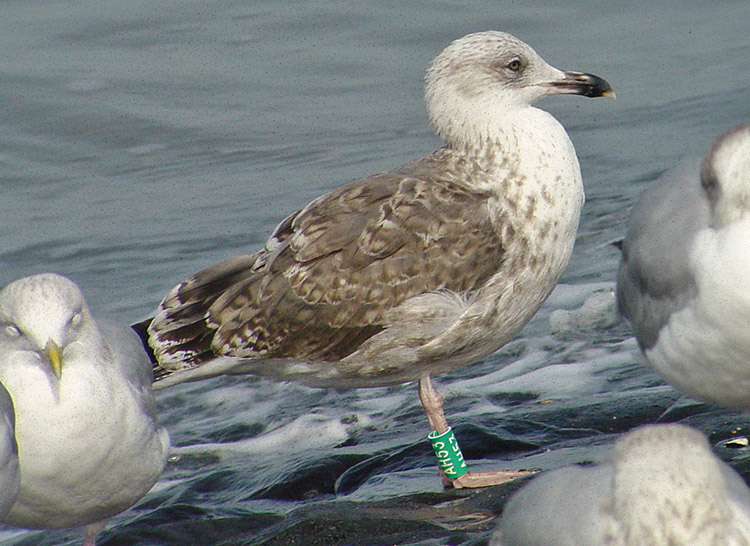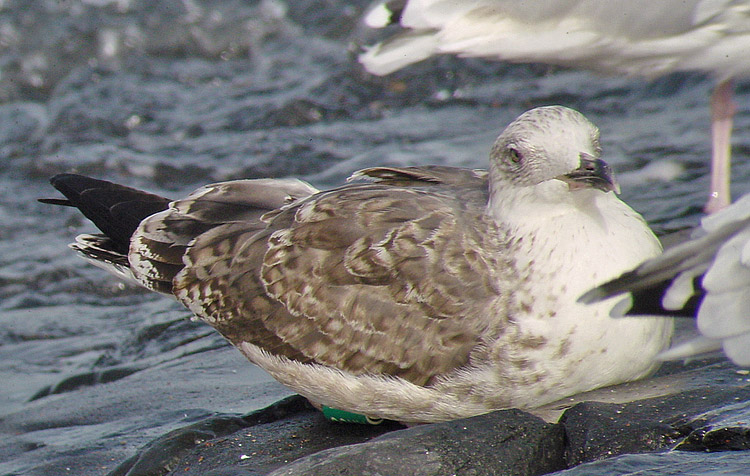 Lesser Black-backed Gull (graellsii & intermedius)
Lesser Black-backed Gull (graellsii & intermedius)
(last update: May 17 2015)
lbbg 1cy May
lbbg 1cy June
lbbg 1cy July
lbbg 1cy August
lbbg 1cy September
lbbg 1cy October
lbbg 1cy November
lbbg 1cy December
lbbg 2cy January
lbbg 2cy February
lbbg 2cy Mar-April
lbbg 2cy May
lbbg 2cy June
lbbg 2cy July
lbbg 2cy August
lbbg 2cy September
lbbg 2cy October
lbbg 2cy Nov - Dec
lbbg 3cy Jan-April
lbbg 3cy May
lbbg 3cy June
lbbg 3cy July
lbbg 3cy August
lbbg 3cy September
lbbg 3cy October
lbbg 3cy Nov - Dec
lbbg sub-ad Jan-April
lbbg sub-ad May
lbbg sub-ad June
lbbg sub-ad July
lbbg sub-ad Aug
lbbg sub-ad Sept
lbbg sub-ad Oct
lbbg sub-ad Nov
lbbg sub-ad Dec
lbbg adult January
lbbg adult February
lbbg adult March
lbbg adult April
lbbg adult May
lbbg adult June
lbbg adult July
lbbg adult August
lbbg adult September
lbbg adult October
lbbg adult Nov - Dec
(2 images) LBBG 2cy AH53 October 13 2001, Westkapelle, the Netherlands.
This is a 2cy lbbg ringed left green AH53, from Helgoland, Germany and ringed summer year 2000.
Fresh coverts and upper tertials (freshness indicated by the white fringe) still show barring or a (double) anchor pattern. One single scapular appears completely greyish, but even in this feather there is a brownish tint. Clearly, fresh moulted third generation feathers in October may look pretty much like second generation feathers.
Below you'll find a short list of recoveries of colour-ringed LBBG from Helgoland (green rings with white code), a project run by Volker Dierschke.
About the LBBG colour-ringing project on Helgoland (North Sea): The background is that the species started to breed on Helgoland only in 1997 (3 pairs) and increased to c. 50 pairs in 2001 (in parallel to the increase along the Wadden Sea coast). In 1999 and 2000, 13 and 27 non-fledged chicks were ringed with green rings inscripted with white codes (AC, AD, AF, AH plus two digits). So far, 12 birds were reported from elsewhere, some not far from Helgoland at the German and Dutch North Sea coast, some in France, Portugal and Morocco. The reporting rate is 30.0 % (compared to 40.7 % in 337 Herring Gulls ringed in the same scheme). An interesting result is that LBBGs leave the colony and its neighbourhood much quicker than Herring Gulls, with most birds departing from mid August to early September and last departures in mid September.
Dr. Volker Dierschke
Institut fur Vogelforschung "Vogelwarte Helgoland"
Postfach 1220 27494 Helgoland, Germany
Phone +49 4725 306 Fax +49 4725 7471
http://www.vogelwarte-helgoland.de
Ring recovery data indicate that LBBG from the NW coast of Germany follow the same migration route as birds ringed in SW of the Netherlands. They can be found in the Seine estuary and later in autumn, they move further south to Portugal, Morocco and along the coast of West Africa to Senegal, where rich feeding grounds can be found. The main diet is fish.
| code |
date
|
location |
coord.
|
| AD03 |
3-7-99
|
Helgoland, D |
54.11 N, 07.55 E
|
| AD03 |
27-10-99
|
Matosinhos, Douro Litoral, P |
41.11 N, 08.42 W
|
| AD03 |
29-6-00
|
Seine-Ästuar, Le Havre, F |
49.27 N, 00.10 E
|
| AD03 |
30-6-00
|
Seine-Ästuar, Le Havre, F |
49.27 N, 00.10 E
|
| AD03 |
18-8-00
|
Marais D'Olonne, Vendée, F |
46.33 N, 01.47 W
|
| AD03 |
15-9-00
|
La Paracou, Les Sables D'Olonne, Vendée, F |
46.31 N, 01.48 W
|
| AD03 |
26-9-00
|
Marais D'Olonne, Vendée, F |
46.33 N, 01.47 W
|
| AD03 |
18-10-00
|
Le Tanchet, Les Sables D'Olonne, F |
46.29 N, 01.45 W
|
| AH24 |
10-7-00
|
Helgoland, D |
54.11 N, 07.55 E
|
| AH24 |
14-9-00
|
Marais D'Olonne, Vendée, F |
46.33 N, 01.47 W
|
| AH24 |
15-9-00
|
La Paracou, Les Sables D'Olonne, Vendée, F |
46.31 N, 01.48 W
|
| AH59 |
14-7-00
|
Helgoland, D |
54.11 N, 07.55 E
|
| AH59 |
21-9-00
|
Seine estuary, Le Havre, F |
49.30 N, 00.14 E
|
| AH59 |
30-9-00
|
Seine estuary, Le Havre, F |
49.27 N, 00.10 E
|
| AH93 |
22-7-00
|
Helgoland, D |
54.11 N, 07.55 E
|
| AH93 |
8-2-01
|
Oued Sous, Agadir, Morocco |
30.22 N, 09.37 W
|
| AH94 |
22-7-00
|
Helgoland, D |
54.11 N, 07.55 E
|
| AH94 |
7-9-00
|
Dannes, Pas-de-Calais, F |
50.35 N, 01.36 E
|

